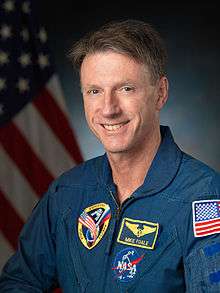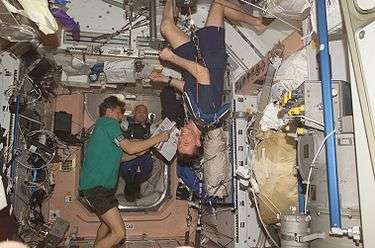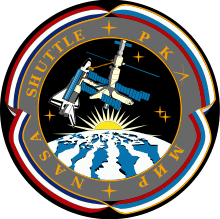Michael Foale
| Colin Michael Foale CBE | |
|---|---|
 | |
| NASA Astronaut | |
| Nationality | British / American |
| Status | Retired |
| Born |
January 6, 1957 Louth, Lincolnshire, England |
Other occupation | Astrophysicist |
Time in space | 373d 18h 18m |
| Selection | 1987 NASA Group |
| Missions | STS-45, STS-56, STS-63, STS-84, Mir NASA-4 (Mir EO-23 and 24), STS-86, STS-103, Soyuz TMA-3 (Expedition 8) |
Mission insignia |
|
Colin Michael Foale, CBE, PhD (born 6 January 1957) is a British-American astrophysicist and former NASA astronaut. He is a veteran of six Space Shuttle missions and extended missions on both Mir and the International Space Station. He was the first Briton to perform a space walk, and until 17 April 2008, he held the record for most time spent in space by a US citizen: 374 days, 11 hours, 19 minutes. He still holds the cumulative-time-in-space record for a UK citizen.
Life and career
Foale was born in Louth, Lincolnshire to a British father, Colin, and an American mother, Mary. He was raised in Cambridge and educated at The King's School, Canterbury. A member of the Air Training Corps, he studied at Queens' College, Cambridge, (with Stephen Fry who mocked his ambition of going to space) receiving a first-class honours degree in natural sciences in 1978 and a doctorate in laboratory astrophysics in 1982. When he left university he "owned two pairs of jeans, a donkey jacket, a bicycle and a pilot's licence; which shows I had my priorities absolutely right."[1]
While a postgraduate student at Cambridge University, Foale participated in the organization and execution of scientific scuba diving projects. Pursuing a career in the U.S. Space Program, Foale moved to Houston, Texas, to work on Space Shuttle navigation problems for McDonnell Douglas. In June 1983, Foale joined NASA Johnson Space Center in the payload operations area of the Mission Operations Directorate. In his capacity as payload officer in the Mission Control Center, he was responsible for payload operations on Space Shuttle missions STS-51G, 51-I, 61-B and 61-C.
Born in the United Kingdom, Foale applied and was turned down twice as an astronaut candidate. After the Space Shuttle Challenger disaster in January 1986, Foale changed his application essay from writing about his dreams to focusing on the realities of leadership faced by NASA, and was selected in 1987.[1]

(click to enlarge)
He flew on space shuttle missions STS-45 (1992), STS-56 (1993) and STS-63 (1995). In the last mission he undertook a four-hour EVA. He was then selected for an extended mission aboard the Russian Mir space station.
Launched by STS-84 and returned by STS-86, Foale spent four months on Mir in 1997 during the Mir 23 and Mir 24 missions. During Mir 23, the station's Spektr module was struck by a Progress resupply vessel.[2] Using knowledge from his physics degree Foale made calculations of how the stars were moving past his fixed-point thumb reference on a window, and was thus able to advise Russian ground control of how to stop the resulting roll.[1] The two Russian cosmonauts of Mir 23, Vasily Tsibliyev and Aleksandr Lazutkin, conducted an intravehicular activity (IVA) to inspect the collision damage from the interior of the space station. During Mir 24, Foale and Russian cosmonaut Anatoly Solovyev conducted a six-hour EVA in the Russian Orlan spacesuit to inspect exterior damage to the Spektr module. For his efforts, he was awarded the Yuri A. Gagarin Gold Medal by the Fédération Aéronautique Internationale.[3]
In 1999, Foale was a member of space shuttle mission STS-103, during which he conducted an eight-hour spacewalk to replace components of the Hubble Space Telescope. In 2003, Foale was named commander of International Space Station Expedition 8 with cosmonaut Aleksandr Kaleri. Their six-month tour of duty on the station ended on April 29, 2004. For about a year, Foale was Deputy Associate Administrator for Exploration Operations at NASA HQ, Washington D.C. He then supported Soyuz and ISS operations and spacesuit development for NASA in Houston.
In August 2013 it was announced that he was leaving the agency after a 26-year career to work on developing an electric aircraft to advance green aviation technology.[4] Since leaving NASA, Foale has become actively involved in the running of the International Space Schools Education Trust, especially their Mission Discovery and trips to Star City, Russia, giving unique experiences to students around the world. Mission Discovery is held each year at the Guy's Campus at King's College London.
Honours
Foale was awarded an honorary degree from the University of Lincolnshire and Humberside in July 2000[5] and an honorary Doctor of Science degree from the University of Kent in September 2000.[6] He was named a Commander in the Order of the British Empire in the diplomatic list of the New Year Honours in December 2004.[7]
As of 2007, he has been patron to a pastoral house at the Folkestone Academy in Kent, which is also named after him. A street in Foale's hometown was renamed Michael Foale Lane.
Personal life
Married with two children, Foale and his family live in suburban Houston, Texas. He is fluent in Russian. Foale is qualified to fly fixed-wing aeroplanes up to fast jets, as well as helicopters. He has never owned a brand-new car, and his hobbies include windsurfing and cross-country skiing.
Foale was the driver of a car in 1980 in Yugoslavia, when a truck accidentally veered across the road and smashed into his car, killing his girlfriend and his brother.[1]
His father, Colin Foale, wrote a book in 1999 titled Waystation to the Stars about the astronaut's experiences on Mir.
Mike Foale in his spare time has also worked with ISSET. This involvement is through him taking up the role of the resident astronaut during many of the Mission Discovery programs ran by ISSET. At these programs, Mike shares his experiences of being in space with teenagers, while at the same time helping them learn new skills. He does this throughout the period of the time the program runs for. [8]
References
![]() This article incorporates public domain material from websites or documents of the National Aeronautics and Space Administration.
This article incorporates public domain material from websites or documents of the National Aeronautics and Space Administration.
- 1 2 3 4 On the move: Michael Foale Sunday Times - September 16, 2007
- ↑ Michael Foale (2016-06-22). "Mir Spacecraft: Worst collision in the history of space flight". Witness. BBC News.
- ↑ FAI Awards received by C. Michael FOALE (USA)
- ↑ BBC News science-environment. Retrieved 10 August 2013
- ↑ Profile, University of Lincolnshire and Humberside website; accessed 15 January 2016.
- ↑ News archive - 2000, University of Kent website, 28 September 2000.
- ↑ British-born astronaut given CBE, bbc.co.uk, 31 December 2004.
- ↑ "AYRSHIRE TO HOST OUT OF THIS WORLD OPPORTUNITY". Retrieved 30 November 2016.
External links
| Wikimedia Commons has media related to Michael Foale. |
